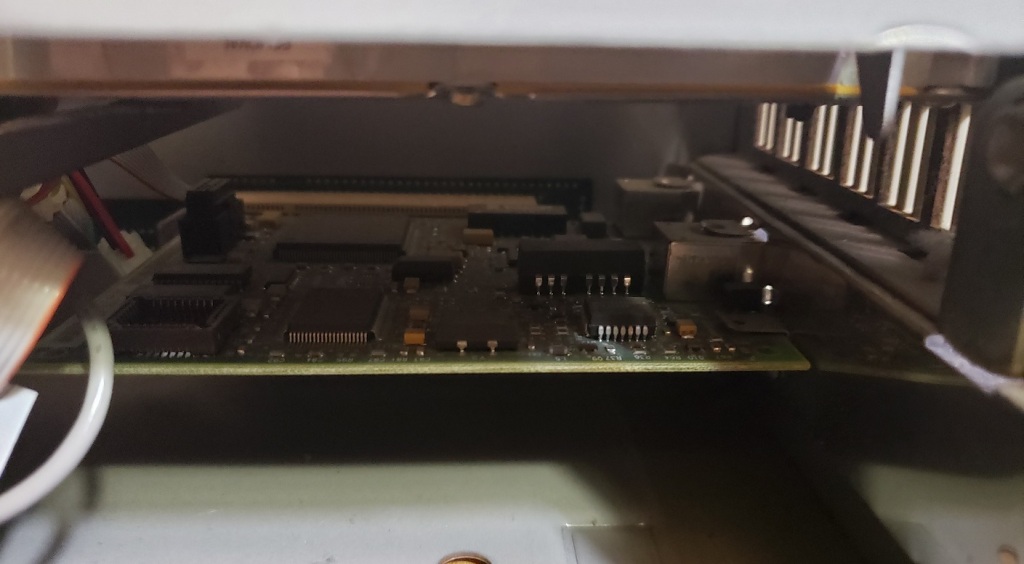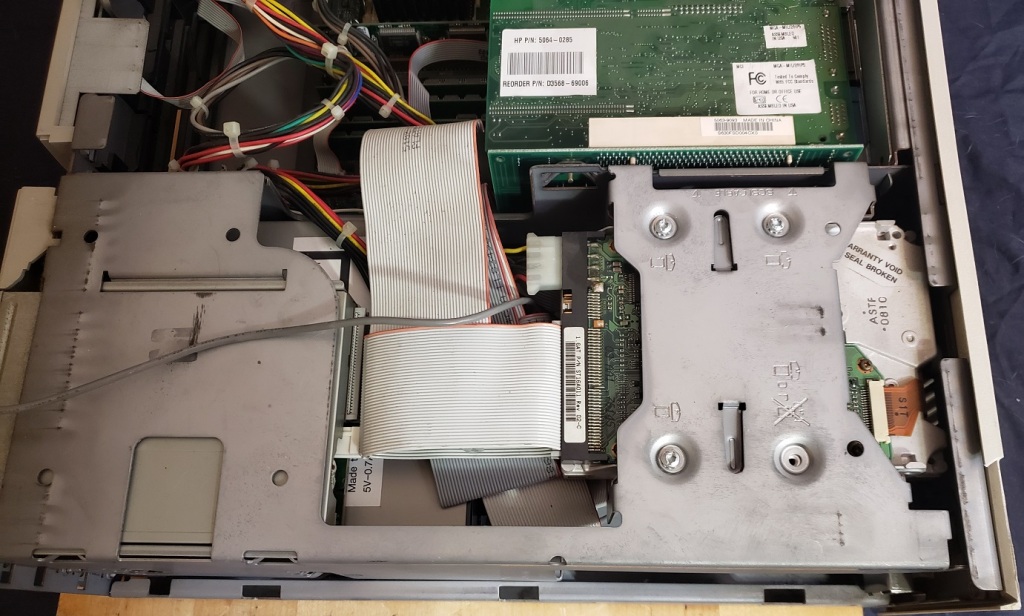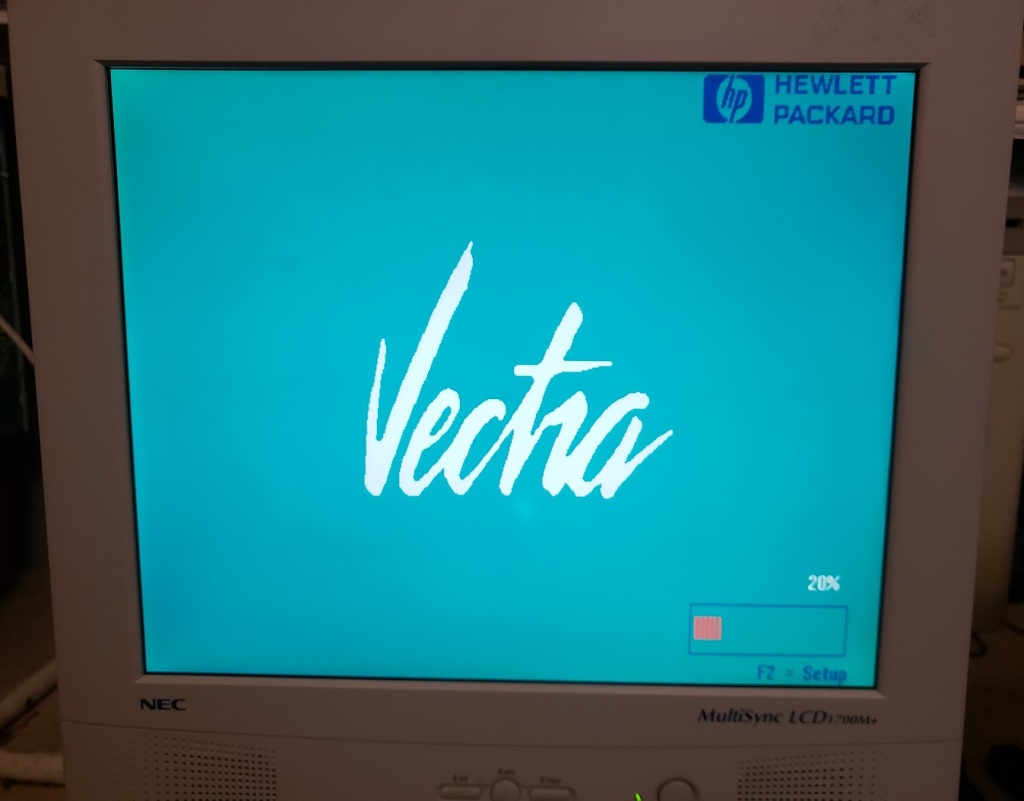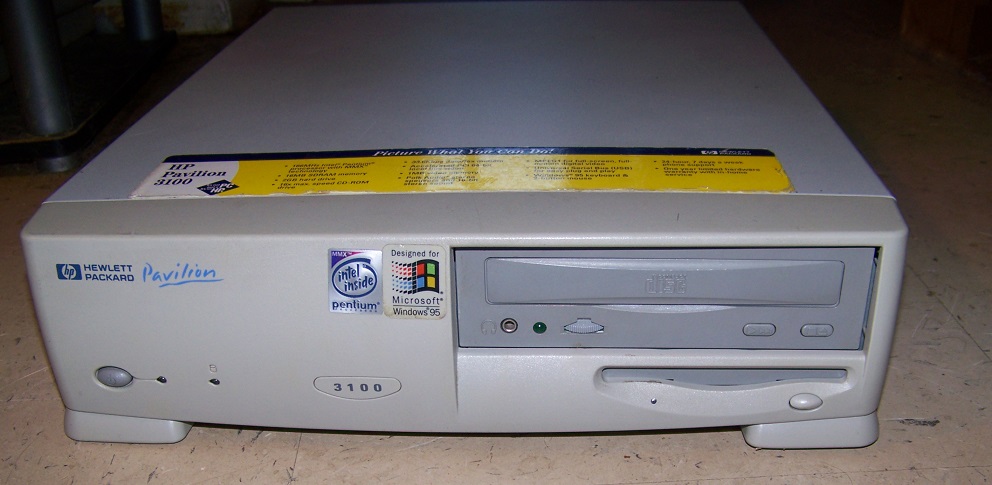Last time we looked at an HP Vectra it was the Vecta XA. This time we are going to take a look at the slightly older Vectra VL and more specifically the Vectra VL series 3 5/90.
The VL series 3 5/90 that I have is in a desktop form factor. I wouldn’t really call it a small form factor but it isn’t as tall as some desktop cases. The center of the faceplate is removable and mine actually came with it missing. I had to source a new one on eBay. In the center we have a large square power button as well as a power LED and HDD activity LED. to the right of this is one 5 1/4 drive bay and one 3 1/2 inch bay commonly populated by a 1.44mb floppy drive and one CD-ROM drive but obviously these can be substituted by whatever drives will fit. Keep in mind these bays use drive rails to secure the drives.
on the bottom rights and left are two plastic tabs. They secure the case lid which can be removed by clicking these tabs inward and then pulling the case lid forward and up.
One the rear left we have a key lock which on my machine is missing as well as a spot below that appears to be an expansion bay. On some models like the XA a special network card would install here but the card and connector for it is not present on VL. To the right we have five expansion slots and underneath these we have a variety of ports.
From left to right we have a parallel port followed by two serial ports, two PS/2 ports for keyboard and mouse and finally a 15 pin VGA port with a standard three-prong power connector above.
The VL uses the same 100w proprietary form factor power supply as the Vectra XA. This power supply has a fan on the underside which blows directly onto the CPU socket for active cooling.
The expansion slots are all on a riser card coming off the motherboard.
For expansion we have two PCI and three 16-bit ISA slots. It’s a bit anemic with the PCI slots but for a basic setup it’s not to bad considering there is VGA built-in. For my build I decided to add a PCI video card, a Voodoo 1 3D accelerator and an ISA sound card which we will take a quick look at later.
Behind the expansion slots is a metal plate on a hinge that with the removal of a screw opens up and allows the installation of a hard drive.
My Vectra VL did not have a hard drive with it so I installed a spare drive I had lying around and installed DOS 6.22 as well as Windows 3.1 though the machine is capable of running Windows 95 or 98 if you choose to.
And now to take a look at the motherboard with the PSU out of the way.
1) CPU – The Vecta VL uses socket 5 which was a fairly short lived CPU socket from around 1994 before socket 7 came out. Socket 5 officially supports the Pentium 75-120MHz but also supports various AMD K5, IDT and overdrive chips.
As per the model designation (series 3 5/90) the stock CPU was a Pentium 90 though my model came with a 200MHz MMX Pentium Overdrive.
The overdrive chip uses a pin adaptor and a voltage regulator to safely install into and run on a socket 5 motherboard. Since socket 5 motherboards do not support the lower voltages and split voltages of later Pentium CPU’s the voltage regulator on the Overdrive chips is required. The BIOS on my Vectra VL on boot detected the Overdrive as a 133MHz chip but running CPUID confirmed the CPU was running at 200MHz.
I did end up removing this CPU and replacing it with a stock Pentium 90.
2) RAM – The VL has six RAM slots for 72 pin RAM for a maximum of 192MB of memory. Currently I have 160MB installed via four 32MB sticks and two 16MB sticks.
3) L2 Cache – The VL has 256KB of L2 cache soldered directly onto the motherboard.
4) Video – The built-in video is based on the CL-GD5434 chip. The 5434 is a later video chip from Cirrus Logic running on the PCI bus. There is 1MB of video RAM soldered onto the motherboard but it is expandable to 2MB via the “video memory” socket. with the additional 1MB for a total of 2MB the 5434 chip will support 64-bit mode. The GD5434 should be a fairly speedy and compatible video chip for 2D games and applications. There is also a VESA feature connector located next to the VRAM socket.
The switch box located next to the VESA feature connector is used to set various things like memory parity and can change based on your CPU speed.
5) Power connection – Power connector, CMOS battery and front panel connector
6) Floppy/IDE – One floppy connector and dual IDE connectors for a total of four IDE devices, not that there is really room to install more than a CD drive and single hard drive. Word of warning though, the IDE controller chip is a CMD0640 PCI IDE which is known to corrupt hard drives under certain conditions.
For expansion cards I decided to install an S3 Vision 968 video card with the ram expansion increasing the cards video memory to 4MB. The Vision 968 is the business equivalent of the Trio64 and although it may be a little slower it does support more memory and is said to have a little better image quality. Compared to the on board GD5434 the Vision 968 may actually be a little slower but it does support more memory allowing me to run things at higher resolutions if I choose. Depending on your needs or if you need more free PCI slots you would probably be fine with the on board video.
I also installed a Voodoo 1 3d accelerator card for all those early games that support the Glide API.
The Vectra VL being a more business oriented PC does not have any built in sound so I decided to add an ISA sound card I’ve been wanting to use for a while. The sound card I went with is the Ensoniq Soundscape S-2000.
The S-2000 is Ensoniqs first attempt at a sound card and it’s a pretty successful card. Most late DOS games directly support the Soundscape and it also has built in MIDI capabilities that sound pretty good. The card is sound blaster compatible but does not have a true OPL FM chip so all FM sound is emulated to sometimes less than great effect. One major plus of the S-2000 is the ability to support intelligent mode when using an external MT-32 MIDI module via the joystick port. This a feature that almost all other sound cards lack.
The Vectra line has always been business oriented and the VL is no exception though with a few additions it can make a capable gaming machine for DOS titles or early Windows. Personally I feel like a socket 7 and up machine is better suited for Windows 9x but for late DOS a socket 5 build like the VL is more than capable. The proprietary power supply, limited BIOS options use of the always annoying rails and limited expansion bays does make the VL less than ideal but it can make a serviceable PC in a smaller form factor if you at least add a sound card and possibly a video card depending on your needs.











































